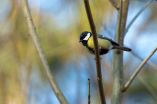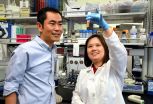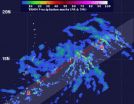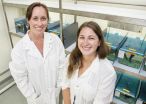(Press-News.org) If you want your doctor to know what goes wrong with your muscles because of age, disease or injury, it's a good idea to know what "normal" actually is. That's where a new research report published in the October 2014 issue of the FASEB Journal comes in. In the report, a team of scientists produce a complete transcriptome—a key set of molecules that can help scientists "see" which genes are active in an organ at a particular time. What's more, they found never-before-detected gene activity and that men have approximately 400 more active genes in their skeletal muscle than women have.
"I hope that the gene activity results from this study will become a reference for human skeletal muscle and provide the basis for many new studies investigating skeletal muscle in different diseases and dysfunctions," said Maléne Lindholm, a researcher involved in the work from the Department of Physiology and Pharmacology at the Karolinska Institutet in Stockholm, Sweden. "In that way, we can understand our muscles better and possibly develop more optimal treatments and a more personalized health care."
To make this advance, Lindholm and colleagues recruited nine male and nine female volunteers. Under local anesthesia, researchers extracted small pieces of skeletal muscle from both legs of each study participant. Gene transcripts were isolated from the muscle pieces and then sequenced, so that the code for all transcripts could be used for comparing samples within a muscle, between individual legs and between men and women. Results from this study produced the whole transcriptome (all transcripts present in the muscles at one time point) of human skeletal muscle in both men and women.
"This report is another important step toward developing treatments based on genome and gender," said Gerald Weissmann, M.D., Editor-in-Chief of the FASEB Journal. "Each gene that has been identified as being active in skeletal muscle is a potential drug target for a variety of muscle diseases, disorders and conditions."
INFORMATION:
Receive monthly highlights from the FASEB Journal by e-mail. Sign up at http://www.faseb.org/fjupdate.aspx. The FASEB Journal is published by the Federation of the American Societies for Experimental Biology (FASEB). It is the world's most cited biology journal according to the Institute for Scientific Information and has been recognized by the Special Libraries Association as one of the top 100 most influential biomedical journals of the past century.
FASEB is composed of 27 societies with more than 120,000 members, making it the largest coalition of biomedical research associations in the United States. Our mission is to advance health and welfare by promoting progress and education in biological and biomedical sciences through service to our member societies and collaborative advocacy.
Details: Malene E. Lindholm, Mikael Huss, Beata W. Solnestam, Sanela Kjellqvist, Joakim Lundeberg, and Carl J. Sundberg. The human skeletal muscle transcriptome: sex differences, alternative splicing, and tissue homogeneity assessed with RNA sequencing. FASEB J. fj.14-255000; doi:10.1096/fj.14-255000 ; http://www.fasebj.org/content/28/10/4571.abstract
Scientists identify which genes are active in muscles of men and women
New report in the FASEB Journal maps the transcriptome of human skeletal muscle, revealing never-before-identified gene activity and that men have more active muscle genes than women have
2014-09-30
ELSE PRESS RELEASES FROM THIS DATE:
Synthetic sperm protein raises the chance for successful in vitro fertilization
2014-09-30
Having trouble getting pregnant—even with IVF? Here's some hope: A new research report published in October 2014 issue of The FASEB Journal, explains how scientists developed a synthetic version of a sperm-originated protein known as PAWP, which induced embryo development in human and mouse eggs similar to the natural triggering of embryo development by the sperm cell during fertilization.
"We believe that the results of this study represent a major paradigm shift in our understanding of human fertilization by providing a precise answer to a fundamental unresolved scientific ...
Genetic test for cancer patients could be cost-effective and prevent further cases
2014-09-30
Screening for a genetic condition in younger people who are diagnosed with bowel cancer would be cost-effective for the NHS and prevent new cases in them and their relatives, new research has concluded.
Researchers at the University of Exeter Medical School were funded by the National Institute for Health Research Health Technology Assessment (NIHR HTA) Programme to assess the effectiveness and cost-effectiveness of screening for Lynch Syndrome. Their findings, published in Health Technology Assessment, indicate that screening the 1,700 people under the age of 50 who ...
Risky metabolism
2014-09-30
This news release is available in German.
Animals often differ in their behavioural response to risky situations such as exposure to predators. Researchers from the Max Planck Institute for Ornithology now found in a long-term study on different populations of great tits that risk-taking behaviour correlates with both metabolic rate and ambient temperature. High metabolic rates and low temperatures were associated with high risk-taking behaviour, as in these scenarios birds were more likely to approach potential predators.
The readiness to take a risk is to a ...
New blood test determines whether you have or are likely to get cancer
2014-09-30
A new research report published in the October 2014 issue of The FASEB Journal may make the early detection of cancer as easy as a simple blood test. This test, called the "lymphocyte genome sensitivity" (LGS) test, could not only detect some cancers earlier than ever before, but it may eliminate the need for some types of biopsies, as well as identify those more likely to develop cancer in the future.
"The test could allow earlier cancer detection, so helping to save peoples' lives," said Diana Anderson, a researcher involved in the work from the School of Life Sciences ...
Tropical Storm Rachel dwarfed by developing system 90E
2014-09-30
Tropical Storm Rachel is spinning down west of Mexico's Baja California, and another tropical low pressure area developing off the coast of southwestern Mexico dwarfs the tropical storm. NOAA's GOES-West satellite showed the size difference between the two tropical low pressure areas.
NOAA's GOES-West satellite captured an image of the Eastern Pacific Ocean on Sept. 30 at 1200 UTC (8 a.m. EDT). In the infrared image, Tropical Storm Rachel appeared small in comparison to the low pressure area called System 90E, coming together hundreds of miles south. As Rachel spins down ...
Virginia Tech researchers discover potential biomarker to detect 'bubble boy' disorder
2014-09-30
Many people recognize "the bubble boy" as an unusual character from a "Seinfeld" episode or a John Travolta movie.
But in reality, a genetic disease called SCID, short for severe combined immunodeficiency, forces patients to breathe filtered air and avoid human contact because their bodies' natural defenses are too weak to fight germs.
Although it affects fewer than 2,000 new births each year worldwide, SCID is a cousin to acquired immune deficiency syndrome triggered by a human immunodeficiency virus — HIV/AIDS.
Now, using a mouse model, Virginia Tech researchers ...
NASA's TRMM satellite sees Tropical Storm Phanfone fragmented
2014-09-30
The bands of thunderstorms wrapping around Tropical Storm Phanfone in the Northwestern Pacific Ocean appeared fragmented to NASA's TRMM satellite.
On Sept. 30, a typhoon watch remains in effect for the far northern Marianas Islands including Pagan and Alamagan. Tropical storm warnings have been cancelled for Tinian and Saipan, but remain in effect for Pagan, Alamagan and surrounding waters. A flash flood watch remains in effect for the island of Saipan. For updated forecasts for these islands, visit the U.S. National Weather Service Office's Guam website: http://www.prh.noaa.gov/guam/cyclone.php.
On ...
A heartbeat away? Hybrid 'patch' could replace transplants
2014-09-30
Because heart cells cannot multiply and cardiac muscles contain few stem cells, heart tissue is unable to repair itself after a heart attack. Now Tel Aviv University researchers are literally setting a new gold standard in cardiac tissue engineering.
Dr. Tal Dvir and his graduate student Michal Shevach of TAU's Department of Biotechnology, Department of Materials Science and Engineering, and Center for Nanoscience and Nanotechnology, have been developing sophisticated micro- and nanotechnological tools — ranging in size from one millionth to one billionth of a meter — ...
In stickleback fish, dads influence offspring behavior and gene expression
2014-09-30
CHAMPAIGN, Ill. — Researchers report that some stickleback fish fathers can have long-term effects on the behavior of their offspring: The most attentive fish dads cause their offspring to behave in a way that makes them less susceptible to predators. These behavioral changes are accompanied by changes in gene expression, the researchers report.
The findings appear in the Proceedings of the Royal Society B: Biological Sciences.
"There is lots of evidence that moms are very important for their offspring," said University of Illinois animal biology professor Alison Bell, ...
How career dreams are born
2014-09-30
COLUMBUS, Ohio – A new study shows just what it takes to convince a person that she is qualified to achieve the career of her dreams.
Researchers found that it's not enough to tell people they have the skills or the grades to make their goal a reality.
Instead, many people need a more vivid and detailed description of just how pursuing their dream career will help make them successful.
This is especially important for people who have the skills and potential to pursue a particular career, but lack the self-confidence, said Patrick Carroll, author of the study and ...
LAST 30 PRESS RELEASES:
Making lighter work of calculating fluid and heat flow
Normalizing blood sugar can halve heart attack risk
Lowering blood sugar cuts heart attack risk in people with prediabetes
Study links genetic variants to risk of blinding eye disease in premature infants
Non-opioid ‘pain sponge’ therapy halts cartilage degeneration and relieves chronic pain
AI can pick up cultural values by mimicking how kids learn
China’s ecological redlines offer fast track to 30 x 30 global conservation goal
Invisible indoor threats: emerging household contaminants and their growing risks to human health
Adding antibody treatment to chemo boosts outcomes for children with rare cancer
Germline pathogenic variants among women without a history of breast cancer
Tanning beds triple melanoma risk, potentially causing broad DNA damage
Unique bond identified as key to viral infection speed
Indoor tanning makes youthful skin much older on a genetic level
Mouse model sheds new light on the causes and potential solutions to human GI problems linked to muscular dystrophy
The Journal of Nuclear Medicine ahead-of-print tip sheet: December 12, 2025
Smarter tools for peering into the microscopic world
Applications open for funding to conduct research in the Kinsey Institute archives
Global measure underestimates the severity of food insecurity
Child survivors of critical illness are missing out on timely follow up care
Risk-based vs annual breast cancer screening / the WISDOM randomized clinical trial
University of Toronto launches Electric Vehicle Innovation Ontario to accelerate advanced EV technologies and build Canada’s innovation advantage
Early relapse predicts poor outcomes in aggressive blood cancer
American College of Lifestyle Medicine applauds two CMS models aligned with lifestyle medicine practice and reimbursement
Clinical trial finds cannabis use not a barrier to quitting nicotine vaping
Supplemental nutrition assistance program policies and food insecurity
Switching immune cells to “night mode” could limit damage after a heart attack, study suggests
URI-based Global RIghts Project report spotlights continued troubling trends in worldwide inhumane treatment
Neutrophils are less aggressive at night, explaining why nighttime heart attacks cause less damage than daytime events
Menopausal hormone therapy may not pose breast cancer risk for women with BRCA mutations
Mobile health tool may improve quality of life for adolescent and young adult breast cancer survivors
[Press-News.org] Scientists identify which genes are active in muscles of men and womenNew report in the FASEB Journal maps the transcriptome of human skeletal muscle, revealing never-before-identified gene activity and that men have more active muscle genes than women have




